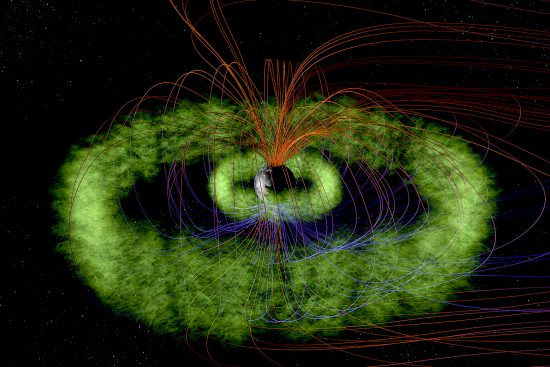
Clouds of charged particles called the Van Allen Belts surround Earth. Credit: NASA/T. Benesch, J. Carns
Oct 2, 2018
Magnetic reconnection does not drive electromagnetic events.
Upper regions of Earth’s atmosphere are influenced by solar emissions, because the ionosphere is connected to the Sun by filaments of electric charge. At 150 kilometers altitude, Earth’s electromagnetic field exhibits the greatest conductivity in what is called the “dynamo region”, where the most powerful charge flow along Earth’s geomagnetic equator takes place. Earth is connected to solar circuits that drive electric forces between the ground and the ionosphere, reaching as much as 400,000 volts. That electrical connection between charged bodies in space is a basic tenet of Electric Universe theory.
The magnetotail (or plasma tail) extends outward from Earth for millions of kilometers, always pointing away from the Sun. Charged particles ejected from the Sun are captured by Earth’s magnetosphere, where they collect in a plasma sheet within the magnetotail. Electromagnetic disturbances and vertical electric currents flowing down to Earth from the solar wind were named, “Birkeland currents” by Alex Dessler in 1967, and were subsequently detected by the TRIAD satellite, launched on December 2, 1972.
TRIAD detected what are now known as the “Van Allen belts”, circling Earth’s equatorial region and extending almost into the Arctic Circle. The inner belt is composed of 10 million-electron-volt protons and is located between 700 kilometers and 12,000 kilometers altitude. The outer belt is primarily electrons, with energies greater than one million electron volts, located in a region that extends from 25,000 kilometers in space, out to 40,000 kilometers. The Van Allen belts are always present in space and must be avoided by manned space missions, or exposure to them must be minimized, since the radiation in those regions could be lethal.
Birkeland’s electric currents are called, “auroral electrojets”. They are linked to electric circuits that follow Earth’s geomagnetic field, moving into and away from the Arctic and Antarctic regions. NASA scientists labeled this electric effect a “new” discovery in 2009, although Birkeland’s research took place in the early part of the 20th century. Astrophysicists acknowledge electromagnetism in their published papers, but persist in seeing “magnetic collisions” in plasma, without the fundamental electric charge flow.
There are many problems associated with the theory of magnetic reconnection that this paper does not address. How so-called, “magnetic energy” is released, or what starts the “merging” process are controversial subjects. Magnetic energy is thought to reappear in different forms. Some becomes heat, while some is conventionally thought to energize electric currents in a circuit linked with Earth.
In an Electric Universe, charge separation exists around Earth because ionospheric plasma interacts with its magnetic field, which induces electric fields and electric charge flow. The “tidal wind charge effect” is connected to the Sun by Birkeland current filaments. Earth’s rotation creates a 140,000 ampere current through transformer action in the dynamo region. Transformer action and electromagnetic induction create bands of opposite charge that move east and west around the planet, following the geomagnetic equator.
As written many times in the past, there is no such thing as “magnetic merging” or “reconnection” of magnetic field lines in the real world. The energy is electrical and comes from electric fields, which, unlike nonexistent magnetic field lines, can merge and detonate.
Stephen Smith












